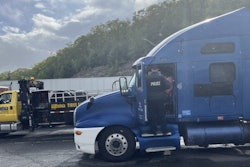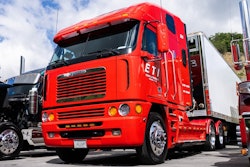Cover Story
The Kenworth T680 draws upon T660 and T700 designs, but still has its own spacious flair
The number says it all. Kenworth’s new and best-kept secret T680 falls midway between the T660 and the year-ago-launched T700. The 660 has the traditional, narrow KW cab at 75 inches, the T700 has the 90-inch cab out to the full width allowed by regulation. The T680 falls in the middle with an 83-inch-wide cab.
The T680 launched at the recent Mid-America Trucking Show. Sister-brand Peterbilt shares the basic cab construction in its corresponding 579, also launched at the show.
Scan this QR code or visitwww.truckersnews.com/testdrives to view a photo gallery of this truck. Find a QR reader in your device’s app store.
Both are highly tooled stamped aluminum structures with complex panels joined by Henrob fasteners to create a rigid aluminum cab structure. The rivets are blind and no heads stand out on the smooth cab surface except at the rear corners. This was a deliberate move to aid repairs there when drivers cut too tight and hit the trailer. In this, the T680 again falls between the T660 with its largely exposed Huck-bolt rivets and the smooth aerospace bonded structure that is underneath the sleek panels of the T700.
And in the same way as the T700 picked up strong styling cues from the T660, the new 680 is clearly recognizable as being from the same family DNA.
The new truck
Kenworth wants to appeal to buyers for whom the traditional narrow cab of the T660 is just too tight at the shoulders and too difficult to get back into the sleeper — the seats are necessarily pitched close together. It’s also targeting buyers who feel the T700, as a team truck, is just too wide with its attendant difficulty in seeing down on the passenger side making it more difficult in busy traffic.

The T680 is designed to have wide appeal with its stylish update of the now-established corporate KW look, the extra accommodation over the T660 without the vastness or the T700 and a comprehensive rethink of the all-new interior.
In the concept phase, more than 850 drivers were interviewed and asked to sit in an adjustable cabin space. Engineers varied the cab’s width, length, seating position and so on. The ideal was found to be the 83-inch cab that falls squarely between the existing models.
With a “driver-first” mentality, Jim Bechtold, Kenworth director of product planning, said the goal was to optimize comfort, usability and visibility for a wide range of driver types and sizes.
The resulting 680 is available as a day cab or as a fully integrated sleeper. Worthy of note: The Peterbilt, with significantly different external sheet metal, is available as a day cab or with its Unibilt bolt-up sleeper.
Gauges that previously had migrated across the dash are now reconsolidated and clearly displayed within the arc of the steering wheel.It remains to be seen whether Kenworth’s customers will be loyal to the existing brand and convert to the T680, cannibalizing sales of the existing models, or whether the new truck will appeal to a whole slew of conquest customers currently buying other brands. Most likely, it will be a bit of both.
At the T680 launch, Kenworth announced it had already pocketed an order for 1,000 T860s from TransAm Trucking of Olathe, Kan., a Kenworth account running T660s. All, incidentally, will be PACCAR-powered.
Engineering
The T680 cab features highly tooled door opening pressings and triple-sealed doors that guarantee excellent fit, yet with a pressure relief valve included, finger-only closing door effort. Styling lines in the panels guarantee integrity of the cab and structural stiffness; deep side window provide great visibility to the sides and, through the excellent new mirrors, to the rear.
While it may appear a little funky when looking at the windshield top corner and the side window line, the extra tall windshield brings light into the cab and enables a view of overhead traffic lights without the usual gymnastics involved in peering under the windshield header. The panoramic one-piece windshield is the only configuration available.
The aerodynamic wind-tunnel design was achieved in partnership with Magna International, claimed to be the biggest and most diverse supplier of interior and exterior components for the automotive industry. The T680’s aerodynamic shape benefits from a sculpted full-height roof, an optimized bumper and hood, full-height side extenders, cab/sleeper-to-fairings closeout panels, chassis fairings extenders and flush-mounted lighting. Kenworth says it all adds up to a significant 10 percent enhancement in aerodynamics over existing models, including the T660.
The T680 was engineered with 65 percent more storage capacity than the T660 with a 50 percent larger windshield and 40 percent less interior noise. Significantly, the door openings are 30 percent larger to make the 680 easier to get into.
The hood is wider and lower than the T660’s, with new headlights. These are dual halogen (standard) with optional HID Xenon lamps, which Kenworth says creates the industry’s best forward lighting. The hood is in three parts for easy, less costly repair. The bumper is split for similar reasons.
Along with good side and rear visibility, the forward view is enhanced with a steeply sloping hood and carefully angled “A” pillars for minimum intrusion into the field of view. As is Kenworth’s way, mirrors are cowl-mounted (Peterbilt’s, by contrast, mount to the doors in its traditional fashion).
Cab
On the inside, everything has been done to make practical use of the additional cab width on the new model. The driving position faces a new instrument cluster where gauges that previously had migrated across the dash are now reconsolidated and clearly displayed within the arc of the steering wheel.
Newly designed switches that can be used both as rocker or as toggles spread in Kenworth fashion across the right-hand mildly swept side dash. The steering position is adjustable and the pedals have been redesigned for optimum angles.
“Based on our expandable cab data, we started with the ‘driver’s space,’ creating the ideal position for the pedal package, the optimal seating position and steering wheel location,” says Wally Peltola, Kenworth design director. “The air-assisted hydraulic clutch we designed requires only half the pressure of a traditional clutch, plus less travel, so it’s very easy to engage. It allows a woman in the 5th percentile of size, as well as a male in the 95th percentile, to maintain easy clutch control. That is a major leap forward in accommodating drivers.”
Within the main dash panel is the Driver Performance Center, an all-new, full-color, high-resolution, 5-inch display screen that shows current truck information, diagnostic data and pop-up alerts. It will also display recommendations to help the driver improve vehicle performance.
With the automatic temperature control for heating, ventilation and air conditioning, the driver — or passenger — can simply set the desired temperature and the system will maintain it. A one-touch feature provides maximum defrost.
The Kenworth proprietary seats are actually manufactured and supplied along with other interior modules by Magna. They offer an advanced air suspension system that automatically adjusts to various driver weights. An adjustable shock provides a full range of seat comfort for driver-specific preferences. An optional passenger 180-degree swivel seat allows the occupant to face into the sleeper. This option, which is designed into the space rather than the usual lets-add-a-swivel-seat option, combines with the rotating table to create an industry-leading work and living environment.
Sleeper
The sleeper has been totally redesigned. A unique passenger-side table can swivel back to the bunk. Its rugged work top has been designed to sustain a 450-pound load.
Making the most of this table feature is a foot-operated swivel option for the passenger seat that brings the seat around to face the table. There it can be used as a pull-up chair for work, eating, or other activities. For relaxing, the seat can be kicked back like a La-Z-Boy. The cabinet stack that supports the table has a microwave space over the table, and a flat screen mount on a swivel that means the TV can be seen from the turned passenger seat or swung back for ideal viewing from the bunk.
On the other side of the truck is the refrigerator space that houses an optional slide-out, top-loading fridge and features a step for easy access to the optional upper bunk, where a tent-style restraint encourages use of the safety system.
All in all, it’s an excellently thought-out space. It includes the regular sleeper area that then swings around the driver seat as far forward as the dash, using fully three-quarters of the cab/sleeper space in the new and exciting mid-width cab.
On The Road
Truckers News was one of only a few magazines given the opportunity to drive the new T680 at its launch during the Mid-America Trucking Show. Our route took us out of the Louisville Expo Center west and south toward Elizabethtown for a couple of hours and back again after a truck swap. On the way out, I drove a day cab T680 with Paccar MX power; on the return, an impressive integrated cab/sleeper with Cummins ISX 485.
The most memorable thing about the new cab was its extremely rigid-feeling construction. There is no booming amplification of road or mechanical noise as sometimes occurs with the flat-panel riveted construction of the narrow cab.
Also immediately apparent is the terrific visibility through the low side glass, the panoramic windshield, the sloping nose that can hardly be seen from the driver’s seat, and the excellent cowl-mounted mirrors that are rigid and vibration free.
On the short-wheelbase day cab, the transitions on bridge approach and departure were definitely felt, but the absence of any exterior or cab noise as these events happened was also noticeable. This new truck is extraordinarily quiet. Of course, the low-noise 12-liter Paccar MX in the day cab truck is in part responsible for this.
The 10-speed manual shifted with the usual Kenworth precision and the truck steered well, staying on line and cutting into curves with the first movement of the steering wheel. The new instrument cluster works well, too, with everything in front of the driver and designed for maximum legibility.
Cummins ISX 15The switches’ proximity to the driver is according to function. Controls for the fifth-wheel slider, air dump valve and so on are the farthest reach away because they are used infrequently — and you don’t want to be accidently fiddling with them going down the road, anyway.
The navigation panel is the Kenworth NavPlus execution of the PACCAR driver infotainment system. It is multi-functional and includes the addition of virtual round gauges to supplement the nine gauges in the main dash. In all, there are 12 additional gauges available in the NavPlus.
The driving return loop was in the sleeper truck. With its Cummins ISX 485 and 13-speed UltraShift transmission, it was easy, quiet and a joy to drive. Part of this was attributable to the Kenworth air-ride AG130 front suspension. On the downside, this truck was not as precise in the steering as the day cab. This may be a function of the air suspension or just the fact that it was a much longer wheelbase and so has a slower turn-in than the other.
But given the choice, the big sleeper would be everyone’s favorite workplace for its quiet, comfort and spaciousness.
Ambient red mood lighting adds to the presence of the interior and the new, wider seats offer additional driver comfort.
Kenworth likes the bottom-hinged accelerator pedal, which always makes it a little difficult to place the right foot when using cruise control. Also, the brake pedal sits very close beside the accelerator. But these are small quibbles.
The sleeper appointments are great and work as well in practice as they promise in theory. One particularly great feature is the door-lock switch on the sleeper control panel — a nice touch that shows the engineers really applied themselves and listened to the drivers as they tried to include every detail. I mean, how often have you tumbled out of the bunk just to check door locks?
Summary
The new, wider T680 should prove a very worthy addition to the Kenworth line. It may cannibalize a few sales from its T660 and T700 brothers, but more likely it will acquire new sales from competitive brands that have been introduced more recently than the B-cab T600. And it’s available at the right time to stave off any other new competitors in the pipeline. It is an exceptional new introduction that will be highly popular with drivers and should do well for Kenworth.
DESIGN
The T680 is something new for Kenworth. Instead of using flat aluminum panels, bulkhead-style doors and composite panels for the more complex shapes, the T680 has highly tooled doors and door openings and complex curves in the sheet metal and base cab structure. In developing the design, Kenworth worked with industry giant Magna International, drawing on its expertise in designing and producing the tools that can deep-draw the aluminum into the complex shapes dictated by the 680’s cool styling.
Magna also has industry-leading experience with interior design, mostly on the passenger car side. But the revolutionary interior of the T680 shows evidence of new thinking that maximizes the recreational space available in the cab. As cool as some other interiors look, none comes close to the practicality and space utilization of the integrated T680, though it is essential to specify the swivel passenger seat to gain maximum advantage from the space.
Kenworth T680 Sleeper Test vehicle Specs
Frame: Kenworth steel, 10-5/8 by 5/16 inches, 1,776 pounds RBM
Engine: Cummins ISX 15, 485 hp, 1,650 lb.-ft. torque
Engine brake: Jacobs/Intebrake
Transmission: Eaton Fuller FO16E313A-MHP Ultrashift Plus, 13-speed overdrive
Wheelbase: 229 inches
BBC: 125 inches
Front axle: Dana Spicer E-13221 3.5-inch drop, 13,200 pounds
Suspension: Kenworth AG130 air suspension
Steering: Sheppard HD94
Front brakes: Bendix RSD air discs
Front tires: Michelin XZA3 275/80R22.5
Rear axle: Dana Spicer DSP 41, 40,000 pounds
Suspension: Kenworth AG400L, 40,000-pound air-ride
Ratio: 3.42 to 1
Rear brakes: Bendix RSD air discs
Rear tires: Michelin XDA Energy 275/80R22.5
Wheels: Kenworth 7-spoke hub pilot, outside polished
Fuel tanks: Dual 120-gallon, unpolished
Fifth wheel: Holland FWAAL-17
Seats: Kenworth GT704 HiBack leather passenger on swivel
Interior: Diamond VIT, SlateGray with woodgrain and aluminum
Paint: Spinaker Blue Effect, Imron
Other: heated, motorized mirrors; integral roof fairing, skirts, side extenders; exterior sunvisor; remote keyless entry; AM/FM/CD weatherband radio w/ iPod interface; automatic temperature control HVAC; DPF horizontal opposing SCR; PACCAR 130 amp alternator; Eaton clutch with air-assisted hydraulic pedal; Bendix ABS6 4S/4M anti-lock brake system; stamped aluminum cab with panoramic curved glass windshield.
POWERTRAIN
The new Kenworth T680 is available with the PACCAR MX engine as the standard position, but then there’s the Cummins ISX in its established 15-liter configuration as in the test vehicle. Also released is the 11.9-liter ISX, which Cummins says shares much of the design philosophy of its bigger counterpart. It is, though, quite different in just about every respect.
The 11.9 has seen significant development as a natural gas engine and provides an interesting alternative fuel power unit for the new truck.
For this driving evaluation, we were pleased to see the Cummins ISX at a 485 hp rating. This is a 1,650 lb.-ft. engine, so it offers good performance and excellent fuel economy. Coupled with the 13-speed Ultrashift in this application, it is a very flexible package that should please drivers and owners.
The transmission is an overdrive automated with a top gear ratio of 0.73. With the 22.5-inch Michelin rubber turning 511 revs per mile, the overall gearing gives the truck a tall 1,275 rpm at 60 mph, or 1,380 at 65 mph.
Backing it down to 62 to gain the best fuel economy sees the engine turning at 1,320 rpm, way down the speed range but still with the ability to pull small grades without downshifts. And with the automated transmission in control, the driver doesn’t need to be concerned about that in any case.








